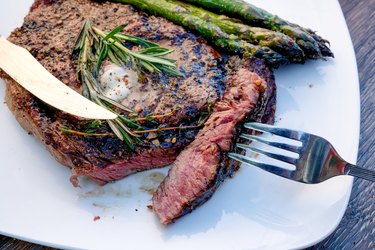
Thinking about having a ribeye steak for dinner and wondering about the health quotient of your meal? Here's what you need to know about ribeye nutrition and calories.
Tip
An 8-ounce ribeye steak has 544 calories.
Video of the Day
Video of the Day
Ribeye Steak Calories
The University of Nebraska-Lincoln explains that ribeye steaks come from the large end of the beef rib, once the back and rib bones of the animal have been removed.
According to the University of Kentucky, this steak, which is usually between 1 and 2 inches in thickness, contains an oval-shaped ribeye muscle. The muscle is visible on both sides of the steak, along with some other smaller muscles. The University of Kentucky notes that while this steak has a little fat and connective tissue in between the muscles, it does not really have a lot of fat on the outside.
According to the USDA, an 8-ounce rib eye steak has 544 calories. However, the American Heart Association recommends that you limit your serving size of meat to 3 ounces of cooked lean meat, so you may not want to eat the whole 8-ounce ribeye steak in one go.
Instead, you can pair the steak with side dishes like salads and roasted vegetables to add fiber and other nutrients to your meal. A small study published in the January 2012 issue of the American Journal of Clinical Nutrition found that lean beef can be a healthy addition to your diet, and even reduce your cholesterol level and risk of heart disease, if your overall diet is heart-healthy and low in saturated fat.
Consider Ribeye Nutrition
A December 2016 study published in the Korean Journal for Food Science of Animal Resources explains that beef, like other foods and meats, has two functions in the human diet: to provide nutrition and prevent disease.
Apart from calorie content, the USDA also lists rib eye's nutrition information. An 8-ounce rib eye steak has 42.2 grams of protein, 41.6 grams of fat and 0.45 grams of carbs. Since the carb content is so low, ribeye is not a significant source of sugar or fiber.
An 8-ounce ribeye steak also provides 522 milligrams of potassium, 300 milligrams of phosphorus, 43 milligrams of magnesium and smaller amounts of other nutrients like calcium, selenium, iron, zinc, copper and vitamins A, B, D and K. It also has 115.2 milligrams of sodium and 149.2 milligrams of cholesterol.
According to the Mayo Clinic, grass-fed beef may have more nutrition than regular beef made from cows that are raised on a diet of corn and other grains. Grass-fed beef may have a lower fat content than regular beef and of the total fat content, a higher percentage may be from omega-3 fatty acids and conjugated linoleic acid, which are good for your heart.
Grass-fed beef may also have a higher antioxidant content than regular beef, since it may have more antioxidant nutrients, like vitamin E. Unfortunately, grass-fed beef also tends to be more expensive than regular beef.
Read more: What Is the Healthiest Meat?
- University of Nebraska-Lincoln: “Meat Cuts ID and Cooking Recommendations — Rib”
- University of Kentucky: “Beef Cattle Discovery — Retail Cuts — Rib Eye Steak”
- USDA FoodData Central: “Beef, Rib Eye Steak, Boneless, Lip Off, Separable Lean and Fat, Trimmed to 0" Fat, Choice, Raw”
- American Heart Association: “What Is a Serving?”
- American Journal of Clinical Nutrition: “Beef in an Optimal Lean Diet study: Effects on Lipids, Lipoproteins and Apolipoproteins”
- Korean Journal for Food Science of Animal Resources: “Characteristics and Health Benefit of Highly Marbled Wagyu and Hanwoo Beef”
- Mayo Clinic: “Grass-Fed Beef: What Are the Heart-Health Benefits?”